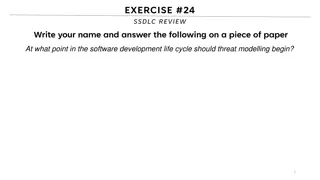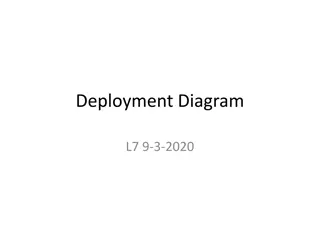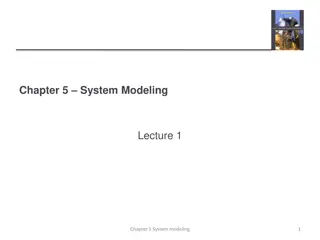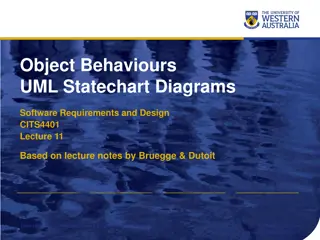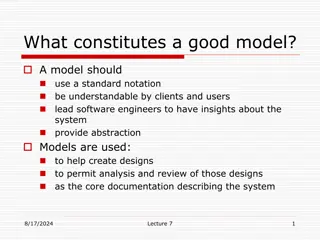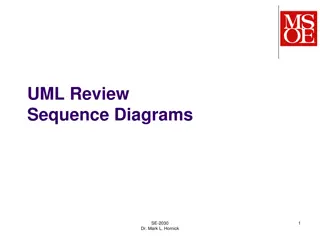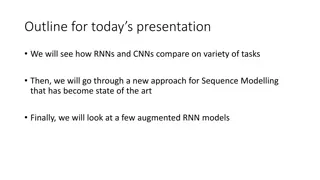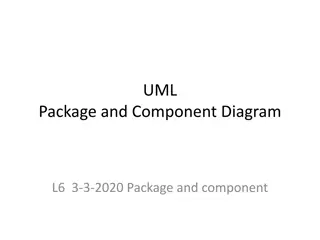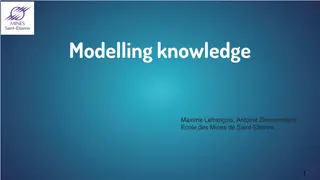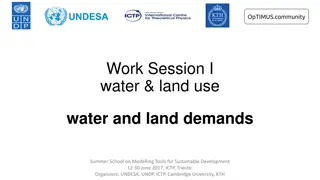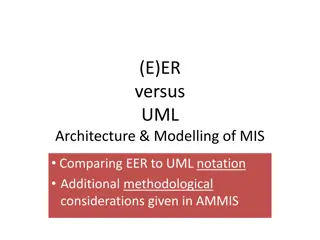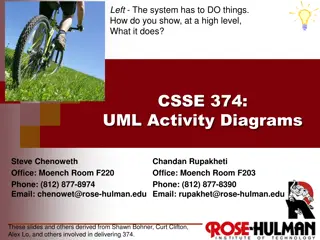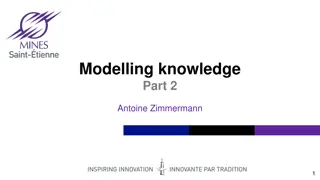Understanding Conceptual and Requirement Modelling Using UML
Enterprise and system models play a crucial role in the business world. This collection of images showcases various aspects of conceptual and requirement modelling using Unified Modelling Language (UML). From business process models to human interactions with software systems, these visual representations provide insights into real-world scenarios and system models. Dive into the world of UML to gain a better understanding of how businesses model their activities and concepts.
Download Presentation

Please find below an Image/Link to download the presentation.
The content on the website is provided AS IS for your information and personal use only. It may not be sold, licensed, or shared on other websites without obtaining consent from the author. Download presentation by click this link. If you encounter any issues during the download, it is possible that the publisher has removed the file from their server.
E N D
Presentation Transcript
Conceptual and Requirement Modelling using Unified Modelling Language (UML) - with solutions Erik Perjons DSV, Stockholm University perjons@dsv.su.se
Real World and Models Business process model of business activities (in UML Activitydiagram) Domainmodel ofbusiness concepts (in UML Class diagram) Human interactionwith softwaresystam (in UML Use cases) Interaction between software objekts (in UML Sequence diagram) System model of softwareobjects (in UML Class diagram) The realworld Graphical models/diagram
Real World and Models Business process model of business activities (in UML Activitydiagram) Domainmodel ofbusiness concepts (in UML Class diagram) Human interactionwith softwaresystam (in UML Use cases) Interaction between software objekts (in UML Sequence diagram) System model of softwareobjects (in UML Class diagram) The realworld Graphical models/diagram
Real World and Models Business process model of business activities (in UML Activitydiagram) Domainmodel ofbusiness concepts (in UML Class diagram) Human interactionwith softwaresystam (in UML Use cases) Interaction between software objekts (in UML Sequence diagram) System model of softwareobjects (in UML Class diagram) The realworld Graphical models/diagram
Real World and Models Business process model of business activities (in UML Activitydiagram) Domainmodel ofbusiness concepts (in UML Class diagram) Human interactionwith softwaresystam (in UML Use cases) Interaction between software objekts (in UML Sequence diagram) System model of softwareobjects (in UML Class diagram) The realworld Graphical models/diagram
Real World and Models Business process model of business activities (in UML Activitydiagram) Domainmodel ofbusiness concepts (in UML Class diagram) Human interactionwith softwaresystam (in UML Use cases) Interaction between software objekts (in UML Sequence diagram) System model of softwareobjects (in UML Class diagram) The realworld Graphical models/diagram
Real World and Models Business process model of business activities (in UML Activitydiagram) Domainmodel ofbusiness concepts (in UML Class diagram) Human interactionwith softwaresystam (in UML Use cases) Interaction between software objekts (in UML Sequence diagram) System model of softwareobjects (in UML Class diagram) The realworld Graphical models/diagram
Real World and Models Business process model of business activities (in UML Activitydiagram) Domainmodel ofbusiness concepts (in UML Class diagram) Human interactionwith softwaresystam (in UML Use cases) Interaction between software objekts (in UML Sequence diagram) System model of softwareobjects (in UML Class diagram) The realworld Graphical models/diagram
Real World and Models Business process model of business activities (in UML Activitydiagram) Domainmodel ofbusiness concepts (in UML Class diagram) Human interactionwith softwaresystam (in UML Use cases) Interaction between software objekts (in UML Sequence diagram) System model of softwareobjects (in UML Class diagram) The realworld Graphical models/diagram
Real World and Models Business process model of business activities (in UML Activitydiagram) Domainmodel ofbusiness concepts (in UML Class diagram) Human interactionwith softwaresystam (in UML Use cases) Interaction between software objekts (in UML Sequence diagram) System model of softwareobjects (in UML Class diagram) The realworld Graphical models/diagram
Enterprise and System Models Enterprise models/ Business models System models
Why enterprise models? Enterprise models are useful for: analyzing business processes and business concepts designing more efficient business processes designing a common conceptual base for the organization providing requirements on software system solutions
Why system models? System models are useful tools for: analysing software systems designing software systems that are align with the business processes designing software systems using a model driven approach
Static and Dynamic Models Static/Structuralmodels - represent static aspects of the real world/system - more precisely: which objects exists and their relationships - answer the question: What things exist? Dynamic/Behavioural models - represent dynamic aspects of the real world/system - more precisely: how does objects and their relationships change - answer the questions: How does the things change
Modelling Language Static/Structural model Abstract Syntax define thelanguage s central concept, usually in form of a metamodel using Concrete Syntax describe which symbols thelanguage consists of and how they looklike, called the notation represented by consistsof using Dynamic/Behavouralmodel
UML Unified Modelling Language (UML) is a general-purpose modelling language/technique which is designed to provide a standard way to visualize the design of a software system - but the language can also be used for enterprise modelling Maintained by Object Management Group (OMG)
UML diagrams UML 2.0 has 13 diagram types, which each provide a certain focus/perspective on a model. According to UML there is one model of a system, and the different diagrams provide different perspectives of that model Class diagram Structure diagram(6) Diagrams(13) Activity diagram Use Case Sequence diagram State machine diag. Behaviour diagram(7)
Real World and Models Business process model of business activities (in UML Activitydiagram) Domainmodel ofbusiness concepts (in UML Class diagram) Human interactionwith softwaresystam (in UML Use cases) Interaction between software objekts (in UML Sequence diagram) System model of softwareobjects (in UML Class diagram) The realworld Graphical models/diagram
Class A class is shown as a rectangle with three compartments: name of the class (use a noun in singular, first letter capital) attribute(s) (use a noun in singular for each atttribute, first letter lower case) operation(s) (use a verb, first letter lower case) Student Name studentNo name mobileNo Attribute registerForCourse() Operation
Class The class can be shown in three different variants We will use the variant in the middle showing the name of the class and the attributes Student Student Student studentNo name mobileNo studentNo name mobileNo registerForCourse()
Class A class groups a set of things with common properties or characteristics Student studentNo name mobileNo
Class A class groups a set of things with common properties or characteristics An attribute is a descriptive property or characteristic of the class Student studentNo name mobileNo
Class A class groups a set of things with common properties or characteristics An attribute is a descriptive property or characteristic of the class Student studentNo name mobileNo
Association Association is shown as a line between classes In order to support interpretation of the association, it should be given a name preferably in form of a verb or verb phrase and it should also be visualized in which direction the name should be read Name of the association Student Course registered at studentNo name mobileNo courseNo courseName Association
Association Association has two directions one from Student to Course and one from Course to Student Student Course registered at studentNo name mobileNo courseNo courseName
Association Only the name of the association in one direction is usually shown, but there is possible to use names in both direction Student Course registered at studentNo name mobileNo courseNo courseName has registered
Association Association shows the roles the objects of the classes can plays towards each other There is a role in each direction of the association: Student plays the role of being registered at course(s) Course plays the role of having registered student(s) Student Course registered at studentNo name mobileNo courseNo courseName
Association It is possible to specify that an association only has one direction by introducing a navigation arrow Student Course registered at studentNo name mobileNo courseNo courseName Association in form of a Navigation arrow
Modelling Class and Objects Instantiation
Class and Association Structure A class and association structure can be seen an information structure, constraining what objects and links are possible to create/instantiate Course Student CourseNo CourseName registers for studentNo name mobileNo Association Class Class
Creating Object and Link structures Class and association structures Object and link structures registers for
Object and Link structures Object and link structures are usually not modelled, but could be: SUPCOM:Course Elsa Falk: Student CourseNo=14 CourseName=SUPCOM registers for studentNo=100123 Name=Elsa Falk mobileNo=070-112233 Link Object Object
Multiplicity Multiplicity describes how many objects (minimum and maximum) of a class that can be linked to objects of an other class in both directions of the association Minimum can be 0 ( cero ) eller 1 ( one ) Maximum can be 1 ( one ) or * ( many ) Customer Order 1..1 0..* customerNo name emailAddress orderNo totalSum placed
Multiplicity Multiplicity describes how many objects (minimum and maximum) of a class that can be linked to objects of an other class in both directions of the association Minimum can be 0 ( cero ) eller 1 ( one ) Multiplicity with min and max value Maximum can be 1 ( one ) or * ( many ) Customer Order 1..1 0..* customerNo name emailAddress orderNo totalSum placed
Multiplicitet Association Customer customerNo name eMailAddress Order placed 0..* Class orderNo totalSum 1..1 :Order :Customer orderNo=9945361 totalSum=5124SEK customerNo=223344 name=Anna L nn eMailAddress=lonn@hotmail :Order :Customer Object orderNo=9945362 totalSum=402SEK customerNo=112233 name:=Zlatan eMailAddress=z@hotmail Link
Multiplicity Multiplicy in the direction from Customer to Order: An object of a class Customer can minimum be linked to 0 and maximum to many Multiplicy in the direction from Order to Customer: An object of a class Customer can minimum be linked to 1 and maximum to 1, that is, exactly one Customer Order placed customerNo name emailAddress orderNo totalSum 1..1 0..*
Multiplicity A guideline to use for helping you deciding multiplicity: Use the phase: One object of Customer is linked to minimum {zero or one} andmaximum {one or many} object(s) of Order , and (in the other direction): One object of Order is linked to minimum {zero or one} andmaximum {one or many} object(s) of Customer Customer Order placed customerNo name emailAddress orderNo totalSum 1..1 0..*
Multiplicity Exercise Your task: Find the violation of multiplicity rules and correct the multiplicity 1..* Owner Car 1..1 nationalIdNo licenceNo :Owner :Car nationalIdNo = 771134 licenceNo=UML123 :Car :Owner licenceNo=OMG234 nationalIdNo= 871211 :Owner :Car nationalIdNo=891223 licenceNo=MDA345
Multiplicity Exercise Your task: Find the violation of multiplicity rules and correct the multiplicity 1..* Owner Car 1..1 nationalIdNo licenceNo :Owner :Car nationalIdNo = 771134 licenceNo=UML123 :Car :Owner licenceNo=OMG234 nationalIdNo= 871211 :Owner :Car nationalIdNo=891223 licenceNo=MDA345
Multiplicity Exercise Your task: Find the violation of multiplicity rules and correct the multiplicity 0..* Owner Car 0..* nationalIdNo licenceNo :Owner :Car nationalIdNo = 771134 licenceNo=UML123 :Car :Owner licenceNo=OMG234 nationalIdNo= 871211 :Owner :Car nationalIdNo=891223 licenceNo=MDA345
Multiplicity Commonly, multiplicity described business rules in the organization (for example, a order must be placed by exactly one customer)
Modelling Generalization in UML Student Student studentNumber name address studentNumber Person name address Teacher name address teacherID Teacher teacherID 44
Modelling Generalization in UML Student studentNumber Person name address ComputerTeacher Teacher teacherID MathTeacher
Modelling generalization in UML Student Subclass Superclass Person Subclass Teacher Real World The Model World
Generalization Generalizering are grouping of classes, where classes totally include others The opposite to generalization is specialization Person is a generalization of Woman and Student Woman and Student are specializations of Person
Domain description This is a domain description of small university library in Sweden For each borrower, the library needs to have information of national ID Number (called personal number in Sweden), name, address and library card number For each employed librarian, the library needs to have national ID Number (called personal number in Sweden), name, address, library card number and employee number A borrower can borrow books. For each loan, the library needs to know which book copy the loan concerns, date of the loan, the date when the copy needs be returned. For each loan, a librarian needs to confirm the loan For each book title the library needs to have information about: author, title, publisher, ISBN, and what category it belongs to. Regarding copies of books, the library needs to have information of the date of purchase of the copy and which copy number the book has (this number is provided by the library directly after purchase). This copy number is used to identify individual copies of a book, because popular books have several copies
BookTitle title author publisher isbn category 1..1 Person name address nationalIDNumber libraryCardNo is item of 1..* Librarian employeeNo Borrower BookCopy copyNo purchaseDate 1..1 1..1 1..1 confirmed_by 0..* BookLoan loanDate plannedReturnDate returned (Y/N) made by 0..* concerns 0..*





